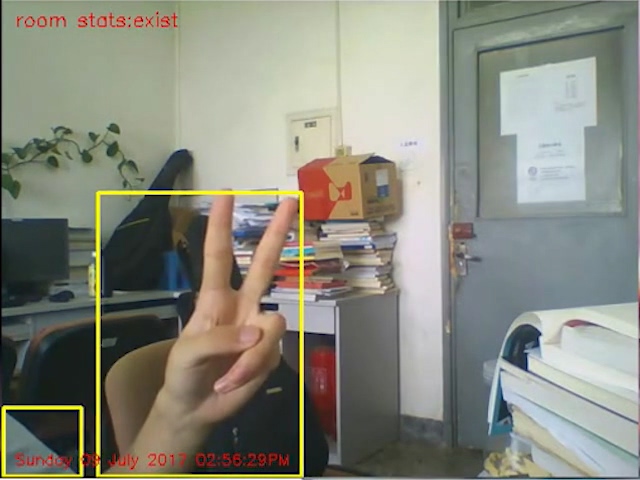1
2
3
4
5
6
7
8
9
10
11
12
13
14
15
16
17
18
19
20
21
22
23
24
25
26
27
28
29
30
31
32
33
34
35
36
37
38
39
40
41
42
43
44
45
46
47
48
49
50
51
52
53
54
55
56
57
58
59
60
61
62
63
64
65
66
67
68
69
70
71
72
73
74
75
76
77
78
79
80
81
82
83
84
85
86
87
88
89
90
91
92
93
|
import argparse
import datetime
import imutils
import time
import cv2
ap = argparse.ArgumentParser()
ap.add_argument("-v", "--video", help="path to the video file")
ap.add_argument("-a", "--min-area", type=int, default=1000, help="minimum area size")
args = vars(ap.parse_args())
if args.get("video", None) is None:
camera = cv2.VideoCapture(0)
originaltime = time.time()
else:
camera = cv2.VideoCapture(args["video"])
firstFrame = None
num=0
while True:
if time.time()-originaltime <= 2:
(grabbed, frame) = camera.read()
else:
(grabbed, frame) = camera.read()
text = "not exist"
if not grabbed:
break
frame = imutils.resize(frame, width = 500)
gray = cv2.cvtColor(frame, cv2.COLOR_BGR2GRAY)
gray = cv2.GaussianBlur(gray, (21, 21), 0)
if firstFrame is None:
firstFrame = gray
continue
frameDelta = cv2.absdiff(firstFrame, gray)
thresh = cv2.threshold(frameDelta, 25, 255, cv2.THRESH_BINARY)[1]
thresh = cv2.dilate(thresh, None, iterations = 2)
(cnts, _) = cv2.findContours(thresh.copy(), cv2.RETR_EXTERNAL,
cv2.CHAIN_APPROX_SIMPLE
)
for c in cnts:
if cv2.contourArea(c)<args["min_area"]:
continue
(x, y, w, h) = cv2.boundingRect(c)
cv2.rectangle(frame, (x, y), (x + w,y + h), (0, 255, 255), 2)
text = "exist"
cv2.putText(frame, "room stats:{}".format(text), (10, 20),
cv2.FONT_HERSHEY_SIMPLEX, 0.5, (0, 0, 255), 1)
cv2.putText(frame, datetime.datetime.now().strftime("%A %d %B %Y %I:%M:%S%p"),
(10, frame.shape[0] - 10), cv2.FONT_HERSHEY_SIMPLEX, 0.4, (0, 0, 255), 1)
cv2.imshow("二值化图像", thresh)
cv2.imshow("差值图像", frameDelta)
cv2.imshow("监控", frame)
cv2.waitKey(10)
flag = True
for c in cnts:
if cv2.contourArea(c)>args["min_area"]//4:
flag = False
if flag is True:
firstFrame = cv2.addWeighted(firstFrame, 1-0.618, gray, 0.618, 0.0)
camera.release()
cv2.destroyAllWindows()
|

